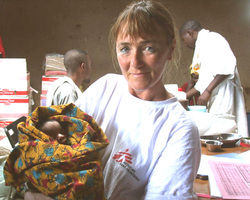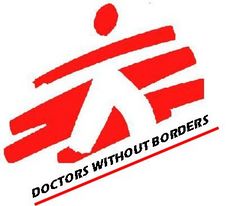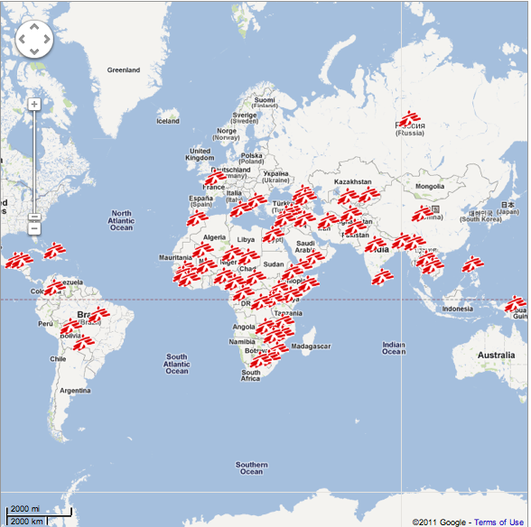Médecins Sans Frontières:
History, Development, & Mission
-History and Development

The Médecins Sans Frontières (MSF), known to North America as Doctors Without Borders, formed when a former Red Cross group, unable to keep their neutrality in wake of an futile aid effort in Nigeria, and a band of volunteers for natural-disaster aid coalesced forces in 1971. In the organization’s early days, it experienced celebrity status in the media with a large part of thanks to their charismatic leader Bernard Koucher, and were portrayed as “medical mavericks” (Bortolotti 14): a reputation that has stuck throughout the years. However, in 1978, the newcomers to the organization spoke out against Koucher’s media obsession and removed him from the organization on ideological differences and started a bolder and more verbal new campaign against oppressors, while adding offices in numerous new locations such as Belgium, Switzerland, Holland, Spain and Luxemburg (Bortolotti 14).
Later on, in the 1980’s which came to be known as the golden age of humanitarianism (which is to say it had not been utilized by governments as a form of propaganda), Médecins Sans Frontières enjoyed an astounding amount of popularity. Most notably for their secret crossing into Afghanistan to provide aid to rural areas for affected civilians during the Russian invasion and later for their work in the physical and mental rehabilitation of the citizens of Sri Lanka during it’s brutal civil war. In Afghanistan, their goal of a long lasting medical system proved difficult, a common problem faced, when the experience of the nurse trainees, in the words of then volunteer Jerry R. Dwek in a lecture given after his return, the “concept of a sphygmomanometer was as foreign as the balloon on a Foley catheter”. In another instance, the Taliban tried to stop the only female nurse from working, and only after extended negotiation, was the woman permitted to work (Dwek). At the end of this decade, Médecins Sans Frontières’ popularity grew so great, that when a poll given to French citizens asked their ideal jobs, a “third of them said they wanted to be Medecin Sans Frontieres” (Bortolotti 14).
Later on, in the 1980’s which came to be known as the golden age of humanitarianism (which is to say it had not been utilized by governments as a form of propaganda), Médecins Sans Frontières enjoyed an astounding amount of popularity. Most notably for their secret crossing into Afghanistan to provide aid to rural areas for affected civilians during the Russian invasion and later for their work in the physical and mental rehabilitation of the citizens of Sri Lanka during it’s brutal civil war. In Afghanistan, their goal of a long lasting medical system proved difficult, a common problem faced, when the experience of the nurse trainees, in the words of then volunteer Jerry R. Dwek in a lecture given after his return, the “concept of a sphygmomanometer was as foreign as the balloon on a Foley catheter”. In another instance, the Taliban tried to stop the only female nurse from working, and only after extended negotiation, was the woman permitted to work (Dwek). At the end of this decade, Médecins Sans Frontières’ popularity grew so great, that when a poll given to French citizens asked their ideal jobs, a “third of them said they wanted to be Medecin Sans Frontieres” (Bortolotti 14).
MSF Areas of Involement

In the 1990’s, it can be said the humanitarian landscape shifted from a golden to rusted age, when the negative side of aid came into the light (Aid to the Hutus in Rwanda and massacres in Bosnia failed to be stopped in UN “safe zones”) conversely, it was this decade that MSF received the Nobel Peace Prize (1999) for their work. At the turn of the century, Médecins Sans Frontières worked during in the wake of the vicious civil war in Sierra Leone and got involved with illegal immigrants searching for shelter and food all over Europe. (MSF) The organization gained a somewhat controversial status in the first half of the 21st during the United States’ invasion of Iraq with claims the U.S. was not holding up their responsibilities to the invaded country’s people. In even more recent years, 2005 and on, much of the focus has been on disaster relief and new vaccinations reaching affected zones all over Africa (MSF).
-Mission
Médecins Sans Frontières is a humanitarian organization, or an organization that “remain[s] neutral in order to get access to victims on all sides”(Borolotti 13) Based on the impartial and ethical practice of medicine, Médecins Sans Frontières are committed to bringing “quality medical care to people in crisis regardless of their race, religion, or political affiliation.”(MSF) Priding itself on “filling gaps” rather than to replicate preexisting services, MSF seeks to provide service to not normally accessible zones for continuation long after the organization leaves the area. (MSF) A neutral organization, MSF depends on private donors, with 90% of its funding coming from these sources. (MFS) Médecins Sans Frontières, in their current practice, spends a great deal of time on what they call their incarnate effect, which is to say the impact they will leave on an area and “is evaluated through a series of criteria like the number of patients treated, deaths, referrals or people who show up at the hospital.” (Cooren 1355)
Works Cited
Bortolotti, Dan. Hope in Hell: inside the World of Doctors Without Borders. Richmond Hill, Ont.: Firefly, 2004. Print.
Cooren, François. "The Coproduction of Organizational Presence:A Study of Médecins Sans Frontières in Action." Human Relations 10th ser. 61 (2008): 1339-370. Print.
Dwek, JR. "The Doctors Without Borders Experience: Mission to Afghanistan." Pediatric Radiology. 32.8 (2002): 541-4. Print
Médecins Sans Frontières(MSF) "About MSF." Médecins Sans Frontières. 06 Nov. 2009. Web. 25 Sept. 2011.
Bortolotti, Dan. Hope in Hell: inside the World of Doctors Without Borders. Richmond Hill, Ont.: Firefly, 2004. Print.
Cooren, François. "The Coproduction of Organizational Presence:A Study of Médecins Sans Frontières in Action." Human Relations 10th ser. 61 (2008): 1339-370. Print.
Dwek, JR. "The Doctors Without Borders Experience: Mission to Afghanistan." Pediatric Radiology. 32.8 (2002): 541-4. Print
Médecins Sans Frontières(MSF) "About MSF." Médecins Sans Frontières. 06 Nov. 2009. Web. 25 Sept. 2011.

